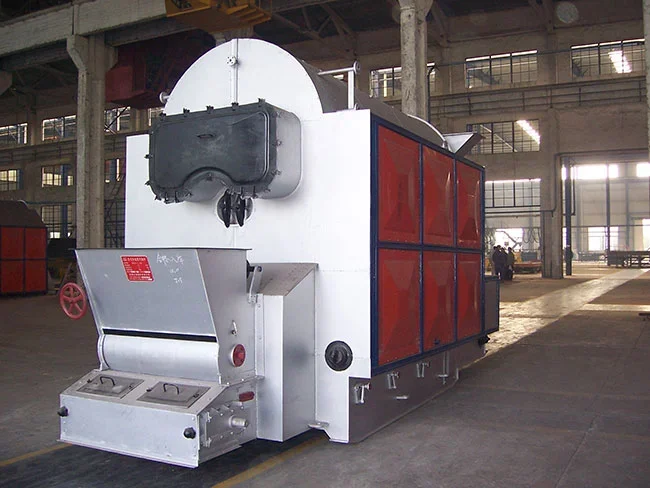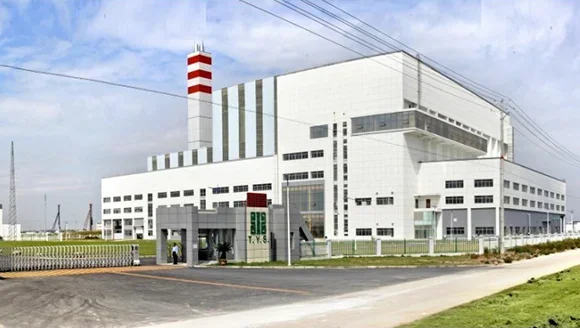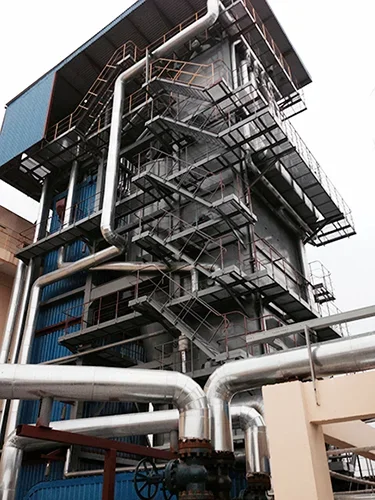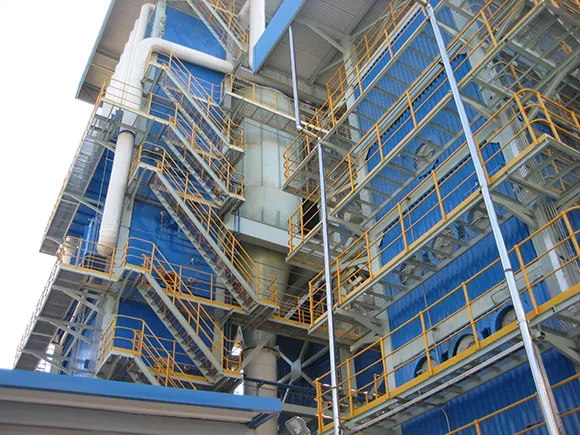Exploring the realm of energy production, coal-fired boilers stand out as stalwarts in generating power efficiently. These robust systems play a pivotal role in various industries, offering reliable heat and steam production. Understanding the inner workings of coal-fired boilers unveils their significance in powering essential processes across sectors. From their combustion mechanisms to environmental impacts, delving into the nuances of these boilers sheds light on their operational intricacies. Unveiling the key components and operational aspects of coal-fired boilers provides valuable insights into their functionality and importance in the energy landscape.
What is a Coal-Fired Boiler
Definition
Coal-fired boilers are systems that use coal as the primary fuel source for heating applications. They operate by burning coal to generate heat, which is then transferred through water or steam to provide warmth.
Coal-fired boilers play a crucial role in both residential and industrial settings due to their efficiency and cost-effectiveness. By utilizing coal as a fuel source, these boilers offer reliable heating solutions that are often more affordable compared to other alternatives.
Applications
In residential settings, coal-fired boilers are commonly used to provide central heating and hot water for homes. These boilers ensure consistent warmth during colder months while offering homeowners a reliable and efficient heating system.
In industrial settings, coal-fired boilers are utilized in various industries such as manufacturing plants, power stations, and food processing facilities. These boilers are integral in processes requiring high temperatures for production, making them essential for industrial operations.
Significance
The significance of coal-fired boilers lies in their ability to efficiently convert coal into heat energy, providing consistent warmth and hot water. This efficiency contributes to cost savings for users, making coal-fired boilers a preferred choice for many seeking economical heating solutions.
Moreover, the adaptability of coal-fired boilers to different settings makes them versatile options for both residential and industrial applications. Their robust design and longevity ensure prolonged usage with minimal maintenance requirements, adding to their appeal among users.

Key Components of Coal-Fired Boilers
Boiler Vessel
The boiler vessel serves as the main structure where water is converted into steam through the combustion of coal. It is designed to withstand high pressure and temperatures, ensuring efficient energy production.
Combustion Chamber
Within the combustion chamber, coal is burned to generate heat, which is then transferred to the boiler's tubes to produce steam. Proper airflow regulation in this area is crucial for optimal combustion efficiency.
Heat Exchanger
The heat exchanger plays a vital role in transferring heat from the combustion gases to the water, increasing the overall thermal efficiency of the boiler. This component helps maximize energy output while minimizing fuel consumption.
Thermo Ash-Regulating Control System
The Thermo Ash-Regulating Control System is a key feature that regulates ash deposition in the boiler. By controlling ash build-up, this system prevents corrosion and maintains peak performance levels over an extended period. It enhances operational stability and prolongs the lifespan of the boiler.
Auxiliary Components
Ash pans are essential auxiliary components that collect and store ash residues produced during combustion. By efficiently managing ash removal, these pans prevent blockages and ensure continuous operation of the boiler. aquastat thermostats help control water temperature within the boiler, optimizing energy usage and enhancing overall efficiency.
How Coal-Fired Boilers Work
Combustion Process
Coal-fired boiler systems utilize pulverized coal firing to generate heat through combustion. In this process, coal is crushed into fine particles and blown into the furnace where it ignites. The burning coal releases energy in the form of heat, which is then transferred to the boiler's tubes.
The intense heat produced by the burning coal causes water within the boiler tubes to heat up and convert into steam. This steam is then directed towards a turbine, where its energy is converted into mechanical power. Subsequently, this power can be used for various applications, such as generating electricity or providing heat for industrial processes.
Heat Distribution
Once the steam has served its purpose in generating power, it condenses back into water and returns to the boiler for reheating. The cycle continues as fresh water enters the system to replace the steam that has been used. This continuous process ensures a constant supply of steam for various heating applications.
In steam heating systems, the generated steam travels through pipes to radiators or other heat exchangers located throughout a building. As the steam passes through these devices, it releases its heat energy, warming the surrounding air. This heated air is then circulated through the building via vents or ducts, providing warmth to occupants.
Ash Removal System
During combustion, coal produces ash as a byproduct. Accumulation of ash can impede the boiler's efficiency by blocking airflow and reducing heat transfer capabilities. To address this issue, coal-fired boilers are equipped with an ash removal system.
The ash removal system efficiently collects and removes ash from the boiler, preventing buildup that could hinder performance. Depending on the type of boiler, ash removal may involve mechanical systems that scrape or vacuum ash away, ensuring optimal operation and prolonging the lifespan of the boiler.

Types of Coal-Fired Boilers
Stoker Boilers
Stoker boilers are designed with a mechanical system that feeds coal into the furnace. This system allows for efficient combustion by evenly distributing coal across the grate surface. The operation of stoker boilers involves a continuous and automated process, enhancing their reliability and consistency in heat generation.
Fluidized Bed Boilers
Fluidized bed boilers operate by suspending coal particles in an upward flow of combustion air. This unique design ensures thorough mixing and constant movement of coal particles, leading to higher combustion efficiency. These boilers are known for their ability to burn low-quality fuels effectively, reducing emissions and improving overall performance.
Residential vs. Industrial Boilers
Residential coal-fired boilers are typically smaller in size and cater to individual households or small buildings. They are designed to provide heating solutions efficiently while maintaining compact dimensions suitable for residential spaces. On the other hand, industrial coal-fired boilers are larger in scale and are utilized in factories, power plants, and large commercial buildings to meet high energy demands.
Hand-Fired Systems
Hand-fired systems involve manual feeding of coal into the boiler's combustion chamber. Users have direct control over the fuel input, allowing for adjustments based on heating requirements. While these systems offer flexibility, they require more attention and maintenance compared to automated feed systems.
Automatic Feed Systems
Automatic feed systems are equipped with mechanisms that automatically supply coal into the boiler. These systems ensure a continuous and consistent fuel supply, optimizing the combustion process for enhanced efficiency. Users benefit from reduced manual labor and increased convenience with these automated systems.
-
Pros of Stoker Boilers:
-
Even distribution of coal for efficient combustion.
-
Continuous and automated operation for reliability.
-
Advantages of Coal-Fired Boilers
Cost Efficiency
Coal-fired boilers offer significant cost savings on heating expenses compared to oil, gas, or electric systems. The affordability of coals and fine coal powder makes them a budget-friendly option for heating needs.
Longevity and Durability
One key advantage of coal-fired boilers is their long lifespan and durability. These boilers are built to withstand high temperatures and harsh conditions, ensuring a reliable heating solution for an extended period.
Versatility in Heating Systems
Coal-fired boilers are highly versatile, capable of supporting various heating systems such as hydronic and steam. This versatility allows for flexibility in adapting to different heating requirements, making them suitable for a wide range of applications.
In terms of cost efficiency, coal-fired boilers provide a more affordable heating solution compared to oil, gas, or electric systems. The availability of coals and fine coal powder at lower prices contributes to the economical operation of these boilers.
The longevity and durability of coal-fired boilers make them a reliable long-term investment. With proper maintenance and care, these boilers can last for decades, offering continuous heating support without the need for frequent replacements.
Moreover, the versatility of coal-fired boilers in supporting various heating systems adds to their appeal. Whether it's for hydronic heating in residential buildings or steam generation in industrial settings, coal-fired boilers adapt seamlessly to different requirements.
-
Affordable heating solution
-
Long-lasting and durable
-
Versatile in supporting various heating systems

Industrial Applications of Coal-Fired Boilers
Manufacturing Sector
Industries like manufacturing extensively utilize coal-fired boilers for steam generation and process heating. These boilers play a crucial role in powering various manufacturing processes, ensuring efficient production.
The scalability of coal-fired boilers makes them ideal for the manufacturing sector. They can easily adapt to the varying heating requirements of different manufacturing processes, providing flexibility and reliability.
Food Processing Industry
In the food processing industry, coal-fired boilers are commonly employed for their reliability and cost-effectiveness. These boilers are used for cooking, drying, and pasteurizing food products, contributing to the overall efficiency of food processing operations.
Manufacturers in the food processing industry benefit from the consistent heat output of coal-fired boilers, ensuring precise control over temperature-sensitive processes. This results in high-quality food products meeting industry standards.
Power Generation
Coal-fired boilers are integral to power generation facilities worldwide. Utility boilers, powered by powdered coal derived from sources like anthracite and bituminous coal, produce steam that drives turbines to generate electricity.
Anthracite mines play a significant role in providing high-quality anthracite coal, which is preferred for its clean-burning properties in utility boilers. This ensures reduced emissions and environmental impact during power generation.
Scalability and Flexibility
One key advantage of coal-fired boilers is their ability to scale up or down based on industrial heating demands. This scalability feature allows industries to adjust their energy consumption efficiently, optimizing operational costs and energy usage.
The adaptability of coal-fired boilers to different grades of coal, including steel-grade coal, further enhances their flexibility in meeting diverse industrial needs. Industries can choose the most suitable coal type based on their specific requirements.
Environmental Impact of Coal-Fired Boilers
Carbon Footprint
Burning coal in boilers generates significant carbon dioxide emissions, contributing to global warming and climate change. The combustion process releases large amounts of carbon dust into the atmosphere.
The release of coal dust not only affects air quality but also leads to the formation of smog and acid rain. These environmental consequences highlight the urgent need for sustainable energy solutions.
Advancements in Technology
Technological advancements have played a vital role in reducing the environmental footprint of coal-fired boilers. Innovations such as flue gas desulfurization systems, electrostatic precipitators, and scrubbers help capture pollutants before they are released into the atmosphere.
The development of cleaner coal combustion technologies aims to minimize coal dust emissions and enhance overall efficiency. These advancements pave the way for a more sustainable future by balancing energy needs with environmental preservation.
Transition to Cleaner Technologies
Transitioning to cleaner energy sources is imperative for combating climate change and reducing pollution levels. While coal has been a primary source of energy for decades, the shift towards renewable energy sources like solar, wind, and hydroelectric power is crucial for a greener future.
Investing in renewable energy infrastructure and phasing out coal-fired boilers is essential for achieving long-term environmental sustainability. Embracing cleaner technologies not only reduces coal dust emissions but also fosters a healthier planet for future generations.

Final Remarks
Coal-fired boilers play a significant role in various industrial applications, offering advantages such as cost-effectiveness and reliability. Understanding the key components, operational mechanisms, and environmental impact of these boilers is crucial for informed decision-making. Despite their benefits, the environmental implications of coal-fired boilers cannot be overlooked, urging industries to explore cleaner alternatives for sustainable operations. The industrial sector must prioritize the adoption of greener technologies to mitigate the adverse effects associated with coal-fired boilers and align with global sustainability goals.
Understand the role of high-quality coal-fired boilers in industrial applications
